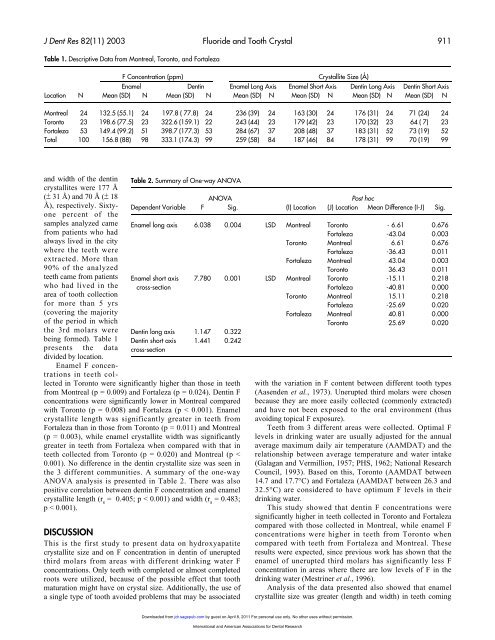Journal of Dental Research - Washington Action for Safe Water
Journal of Dental Research - Washington Action for Safe Water
Journal of Dental Research - Washington Action for Safe Water
Create successful ePaper yourself
Turn your PDF publications into a flip-book with our unique Google optimized e-Paper software.
J Dent Res 82(11) 2003 Fluoride and Tooth Crystal 911<br />
Table 1. Descriptive Data from Montreal, Toronto, and Fortaleza<br />
and width <strong>of</strong> the dentin<br />
crystallites were 177 Å<br />
(+ 31 Å) and 70 Å (+ 18<br />
Å), respectively. Sixtyone<br />
percent <strong>of</strong> the<br />
samples analyzed came<br />
from patients who had<br />
always lived in the city<br />
where the teeth were<br />
extracted. More than<br />
90% <strong>of</strong> the analyzed<br />
teeth came from patients<br />
who had lived in the<br />
area <strong>of</strong> tooth collection<br />
<strong>for</strong> more than 5 yrs<br />
(covering the majority<br />
<strong>of</strong> the period in which<br />
the 3rd molars were<br />
being <strong>for</strong>med). Table 1<br />
presents the data<br />
divided by location.<br />
Enamel F concentrations<br />
in teeth col-<br />
F Concentration (ppm) Crystallite Size (Å)<br />
Enamel Dentin Enamel Long Axis Enamel Short Axis Dentin Long Axis Dentin Short Axis<br />
Location N Mean (SD) N Mean (SD) N Mean (SD) N Mean (SD) N Mean (SD) N Mean (SD) N<br />
Montreal 24 132.5 (55.1) 24 197.8 ( 77.8) 24 236 (39) 24 163 (30) 24 176 (31) 24 71 (24) 24<br />
Toronto 23 198.6 (77.5) 23 322.6 (159.1) 22 243 (44) 23 179 (42) 23 170 (32) 23 64 ( 7) 23<br />
Fortaleza 53 149.4 (99.2) 51 398.7 (177.3) 53 284 (67) 37 208 (48) 37 183 (31) 52 73 (19) 52<br />
Total 100 156.8 (88) 98 333.1 (174.3) 99 259 (58) 84 187 (46) 84 178 (31) 99 70 (19) 99<br />
Table 2. Summary <strong>of</strong> One-way ANOVA<br />
ANOVA Post hoc<br />
Dependent Variable F Sig. (I) Location (J) Location Mean Difference (I-J) Sig.<br />
Enamel long axis 6.038 0.004 LSD Montreal Toronto - 6.61 0.676<br />
Fortaleza -43.04 0.003<br />
Toronto Montreal 6.61 0.676<br />
Fortaleza -36.43 0.011<br />
Fortaleza Montreal 43.04 0.003<br />
Toronto 36.43 0.011<br />
Enamel short axis 7.780 0.001 LSD Montreal Toronto -15.11 0.218<br />
cross-section Fortaleza -40.81 0.000<br />
Toronto Montreal 15.11 0.218<br />
Fortaleza -25.69 0.020<br />
Fortaleza Montreal 40.81 0.000<br />
Toronto 25.69 0.020<br />
Dentin long axis 1.147 0.322<br />
Dentin short axis 1.441 0.242<br />
cross-section<br />
lected in Toronto were significantly higher than those in teeth<br />
from Montreal (p = 0.009) and Fortaleza (p = 0.024). Dentin F<br />
concentrations were significantly lower in Montreal compared<br />
with Toronto (p = 0.008) and Fortaleza (p < 0.001). Enamel<br />
crystallite length was significantly greater in teeth from<br />
Fortaleza than in those from Toronto (p = 0.011) and Montreal<br />
(p = 0.003), while enamel crystallite width was significantly<br />
greater in teeth from Fortaleza when compared with that in<br />
teeth collected from Toronto (p = 0.020) and Montreal (p <<br />
0.001). No difference in the dentin crystallite size was seen in<br />
the 3 different communities. A summary <strong>of</strong> the one-way<br />
ANOVA analysis is presented in Table 2. There was also<br />
positive correlation between dentin F concentration and enamel<br />
crystallite length (r s = 0.405; p < 0.001) and width (r s = 0.483;<br />
p < 0.001).<br />
DISCUSSION<br />
This is the first study to present data on hydroxyapatite<br />
crystallite size and on F concentration in dentin <strong>of</strong> unerupted<br />
third molars from areas with different drinking water F<br />
concentrations. Only teeth with completed or almost completed<br />
roots were utilized, because <strong>of</strong> the possible effect that tooth<br />
maturation might have on crystal size. Additionally, the use <strong>of</strong><br />
a single type <strong>of</strong> tooth avoided problems that may be associated<br />
with the variation in F content between different tooth types<br />
(Aasenden et al., 1973). Unerupted third molars were chosen<br />
because they are more easily collected (commonly extracted)<br />
and have not been exposed to the oral environment (thus<br />
avoiding topical F exposure).<br />
Teeth from 3 different areas were collected. Optimal F<br />
levels in drinking water are usually adjusted <strong>for</strong> the annual<br />
average maximum daily air temperature (AAMDAT) and the<br />
relationship between average temperature and water intake<br />
(Galagan and Vermillion, 1957; PHS, 1962; National <strong>Research</strong><br />
Council, 1993). Based on this, Toronto (AAMDAT between<br />
14.7 and 17.7°C) and Fortaleza (AAMDAT between 26.3 and<br />
32.5°C) are considered to have optimum F levels in their<br />
drinking water.<br />
This study showed that dentin F concentrations were<br />
significantly higher in teeth collected in Toronto and Fortaleza<br />
compared with those collected in Montreal, while enamel F<br />
concentrations were higher in teeth from Toronto when<br />
compared with teeth from Fortaleza and Montreal. These<br />
results were expected, since previous work has shown that the<br />
enamel <strong>of</strong> unerupted third molars has significantly less F<br />
concentration in areas where there are low levels <strong>of</strong> F in the<br />
drinking water (Mestriner et al., 1996).<br />
Analysis <strong>of</strong> the data presented also showed that enamel<br />
crystallite size was greater (length and width) in teeth coming<br />
Downloaded from jdr.sagepub.com by guest on April 8, 2011 For personal use only. No other uses without permission.<br />
International and American Associations <strong>for</strong> <strong>Dental</strong> <strong>Research</strong>



